
Romanov Riches
Russian Writers and Artists Under the Tsars
کتاب های مرتبط
- اطلاعات
- نقد و بررسی
- دیدگاه کاربران
نقد و بررسی

December 1, 2010
The author of numerous works on Russian cultural history races through the 300-year rule of the Romanovs (1613–1917), examining the rulers' complicated relationships with creative artists.
Volkov (The Magical Chorus: A History of Russian Culture from Tolstoy to Solzhenitsyn, 2008, etc.) is not so much interested in specific works, but rather the choreography of artists and emperors. Although he occasionally devotes a few paragraphs to a major work (e.g., Pushkin's Eugene Onegin), the author maintains focus on the personalities and political atmosphere. He begins at the premiere of Mikhail Glinka's opera A Life for the Tsar in 1836; both Pushkin and Turgenev were in the audience awaiting the arrival of Nicholas I. Volkov then moves back to the beginning of the dynasty, to Peter I, whose view of the arts "was utilitarian"—a view shared by a number of his successors. The next major figure is Catherine the Great (the author dispels some of the more bizarre stories about her sexual appetites), who was a writer, a passionate art collector and a patron of the poet Gavrila Derzhavin. Volkov points out a tsarist pattern: Each new one endeavored to ignore the accomplishments of his/her predecessor and to forge a new sort of leadership. Nicholas I, a voracious reader, pulled Pushkin back from exile; other artists danced in and out of favor, as well. The author also tells stories of painters and musicians—sometimes expending pages on sexual speculations (why did the homosexual Tchaikovsky marry?) and with wicked asides about some notables (Tolstoy was "clumsy, ugly, and passive-aggressive"). Volkov often declares the obvious—Crime and Punishment is Dostoevsky's most popular work, and to be fully appreciated, the novel should be read in Russian.
Occasionally cantankerous, but swift, erudite and easy to follow.
(COPYRIGHT (2010) KIRKUS REVIEWS/NIELSEN BUSINESS MEDIA, INC. ALL RIGHTS RESERVED.)

February 15, 2011
The Romanov rule of Russia extended to culture, to art in all its manifest expressions. Volkov (cultural commentator, Radio Free Europe) explores the effect, both contributory and in opposition, of tsarist oversight from the early 17th century through 1917. The interaction between the Romanovs and Russian artists was complementary, contentious, and turbulent. Nonetheless, the achievements are evident in Volkov's well-researched history. The poet Aleksandr Pushkin insisted in his poem "The Village" that serfdom was slavery, indicating freedom should be gained by the tsar's command. Pushkin's complex connections with the Romanovs led to his banishment and later a reprieve as the poet raised the question of the authority of the state vs. the rights of the people. Many such episodes and examples populate this work, a kind of prequel to the author's The Magical Chorus: A History of Russian Culture from Tolstoy to Solzhenitsyn. VERDICT Apart from the welter of names that U.S. readers may find difficult to track, the translated text reads accessibly. While not a revelatory history of tsarist Russia's poetical and cultural machinations, it will help readers understand and appreciate what constituted a working relationship between a ruling class and an untamed group of writers and artists. Recommended for students and readers of Russian history.--Robert Kelly, Fort Wayne Community Schs., IN
Copyright 2011 Library Journal, LLC Used with permission.

February 15, 2011
So intrigued is Volkov with the nexus between art and politics in his native Russia, he follows his acclaimed The Magical Chorus: A History of Russian Culture from Tolstoy to Solzhenitsyn (2008) with a prequel. For the Romanovs, culture was the political instrument par excellence, writes Volkov. But, of course, it wasnt that simple given the clashing egos and worldviews of the czars and the artists they expected to glorify them. In this delectably personified history, Volkov sensitively portrays the second Romanov czar, Alexei, who began the wretched tradition of exiling and imprisoning writers in 1667, and visionary Peter the Great. Volkov has high praise for cultured and bold Catherine II, who chose poet Gavrila Derzhavin as her minister of justice. We meet Mikhail Lomonosov, Russias Leonardo de Vinci, and Vasily Zhukovsky, whose melancholy and mystical ballads meant so much to sensitive Alexander I. Volkov revitalizes our understanding of rebellious poet Pushkin and offers fresh insights into Tchaikovsky, Dostoevsky, and Turgenev. A thrillingly anecdotal and incisive look at the paradigmatic and paradoxical Romanov world of politics, patronage, and the quest for artistic freedom.(Reprinted with permission of Booklist, copyright 2011, American Library Association.)

























دیدگاه کاربران